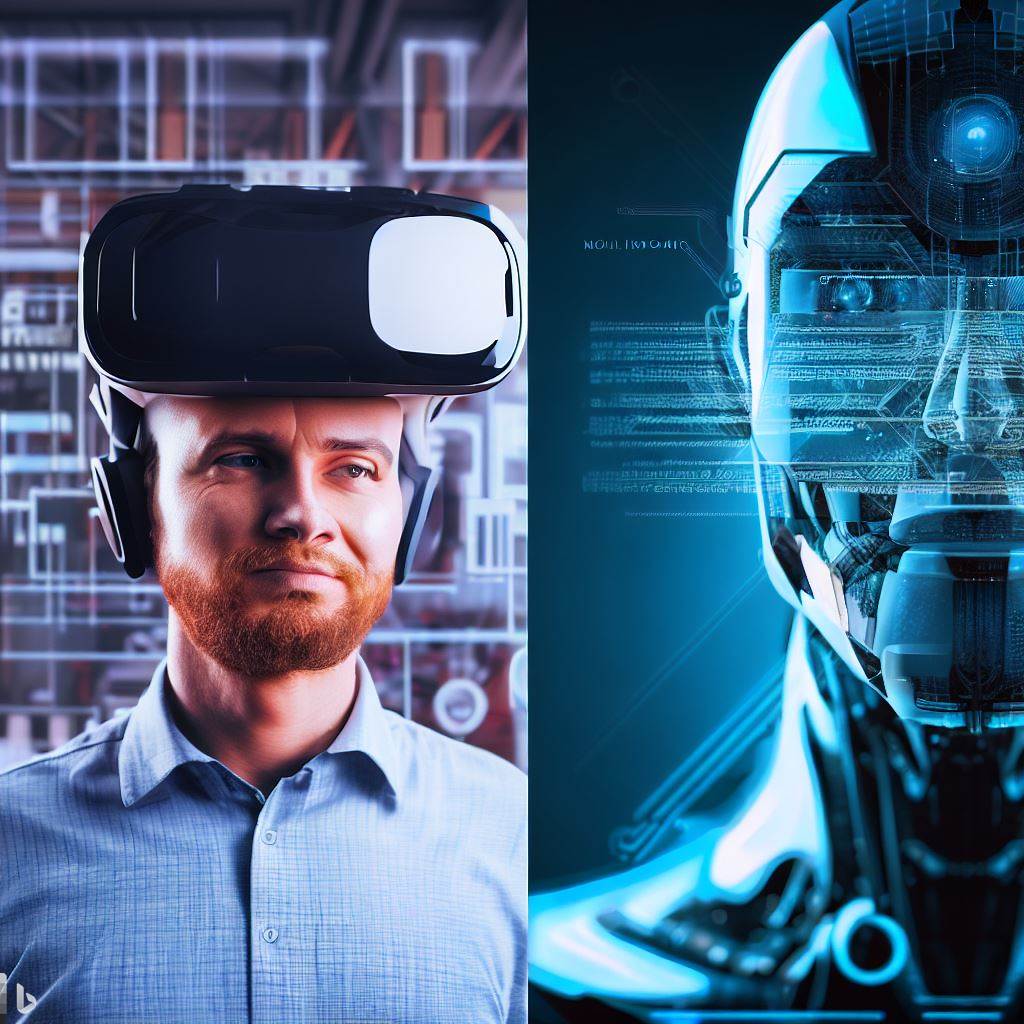Introduction
Are you ready to step into a world where reality bends and coding becomes a thrilling game?
Imagine wearing a headset that transports you to a virtual world or overlays digital elements on your real surroundings.
The ever-growing fascination with VR and AR has given rise to a new trend – coding games. These immersive experiences offer a unique way to learn coding skills by making it enjoyable and interactive.
In recent years, the gaming industry has witnessed a surge in the popularity of virtual and augmented reality.
From exploring distant galaxies to battling fierce dragons, gamers are constantly searching for new ways to be transported into thrilling virtual worlds.
This demand for immersive experiences has paved the way for the integration of coding games into the VR and AR realms.
By combining these technologies with coding, developers have created a whole new dimension of learning.
Coding game experiences in VR and AR offer a unique approach to learning by immersing users in a virtual environment where they can manipulate code and see instant results.
This hands-on approach not only makes coding more engaging but also helps users grasp complex concepts more easily.
Moreover, the gamification of coding has made it accessible to a wider audience.
Whether you’re a seasoned programmer or a curious novice, these experiences provide an interactive and enjoyable way to learn or enhance coding skills.
In fact, the rise in popularity and demand for coding game experiences in VR and AR is transforming the way we learn and engage with coding.
In this section, we will explore the fascinating world of Virtual Reality (VR) and Augmented Reality (AR) technologies and their potential applications in various fields.
What is VR and AR?
In this section, we will explore the fascinating world of Virtual Reality (VR) and Augmented Reality (AR) technologies and their potential applications in various fields.
Virtual Reality
- Virtual Reality (VR) refers to a computer-generated simulation of a three-dimensional environment.
- It creates an immersive digital world by utilizing a combination of visual and audio cues.
- Users can fully immerse themselves in these virtual environments and interact with them in real-time.
- VR technology typically involves the use of specialized headsets and controllers to enhance the experience.
Augmented Reality
- Augmented Reality (AR) is a technology that overlays digital content onto the real world.
- AR enhances the user’s perception of reality by adding computer-generated elements such as images, videos, or sounds.
- Using devices like smartphones or smart glasses, AR seamlessly integrates virtual objects into the physical environment.
- The user can interact with these virtual elements as if they were part of the real world.
Potential in Various Fields
- VR and AR technologies have immense potential across various industries, including gaming, education, healthcare, and engineering.
- In the gaming industry, VR offers an unparalleled level of immersion, allowing players to become fully engrossed in virtual worlds.
- Education can be revolutionized by VR and AR, as they provide interactive and engaging experiences for students.
- Medical professionals can use VR and AR simulations for training, patient education, and even surgical procedures.
- In architecture and engineering, VR and AR enable users to visualize designs in a realistic and interactive manner, streamlining the design process.
- Retail companies can utilize AR to provide customers with virtual try-on experiences and interactive product demonstrations.
- Furthermore, VR and AR have the potential to transform the way we collaborate and communicate remotely.
- Business meetings, conferences, and training sessions can be conducted in virtual environments, regardless of physical distance.
Moreover, VR and AR technologies have the power to revolutionize the way we interact with digital content and the real world.
Tech Consulting Tailored to Your Coding Journey
Get expert guidance in coding with a personalized consultation. Receive unique, actionable insights delivered in 1-3 business days.
Get StartedFrom immersive gaming experiences to innovative educational tools, the potential applications of VR and AR are vast and exciting.
As these technologies continue to evolve, we can expect to see even more groundbreaking developments in various fields.
Read: How Coding Dojo Stands Out Among Coding Bootcamps
The Advantages of Coding Game Experiences in VR and AR
1. Encourages active learning through hands-on experiences
VR and AR coding games provide a hands-on learning experience that actively engages learners in the coding process.
Instead of passively absorbing information, learners can actively experiment and manipulate code in a virtual or augmented environment.
By physically interacting with code, learners gain a deeper understanding of coding concepts as they see the immediate visual impact of their actions.
This active learning approach fosters knowledge retention and helps learners develop practical coding skills.
2. Foster creativity and problem-solving skills in a dynamic virtual environment
VR and AR coding games offer a dynamic and interactive virtual environment that stimulates creativity and problem-solving skills.
Learners can build their own virtual worlds, develop unique game mechanics, and explore imaginative coding possibilities.
These immersive experiences encourage learners to think critically, analyze problems, and come up with innovative solutions.
By experimenting with different approaches and creatively solving coding challenges, learners develop a flexible mindset that can be applied to real-world coding projects.
3. Provide a safe space for trial and error in coding concepts
One of the advantages of VR and AR coding games is that they offer a safe space for learners to make mistakes and learn from them.
In a virtual or augmented environment, learners can freely experiment without the fear of breaking anything.
By allowing trial and error, learners gain a deeper understanding of coding concepts by experiencing both success and failure.
Build Your Vision, Perfectly Tailored
Get a custom-built website or application that matches your vision and needs. Stand out from the crowd with a solution designed just for you—professional, scalable, and seamless.
Get StartedThis iterative process helps learners build resilience, develop problem-solving skills, and refine their coding techniques through continuous experimentation.
4. Enhance engagement and motivation through interactive game elements
VR and AR coding games integrate interactive game elements that enhance learner engagement and motivation.
Gamification elements such as leaderboards, achievements, and rewards provide incentives for learners to actively participate and progress in the coding game.
Through competition and rewards, learners are motivated to explore advanced coding concepts, solve complex challenges, and improve their skills.
The interactive nature of these games keeps learners engaged for longer durations, resulting in a more immersive and productive coding learning experience.
Essentially, the advantages of coding game experiences in VR and AR are numerous.
These innovative learning tools encourage active learning, foster creativity and problem-solving skills, provide a safe space for trial and error, and enhance engagement and motivation.
By immersing learners in a virtual or augmented environment, coding games offer a unique and effective approach to teaching coding concepts and developing practical coding skills.
As technology continues to advance, VR and AR coding games have the potential to revolutionize coding education, making it more accessible, interactive, and enjoyable for learners of all ages and skill levels.
Read: How Companies Use Coding Games for Tech Recruitment

Popular VR and AR Coding Games
Popular VR coding games and their features
- Code VR: This game allows players to learn programming concepts in a virtual reality environment.
- VR Robotics: Users can build and control robots using coding skills in this immersive VR experience.
- VR Game Lab: This game helps aspiring game developers learn coding and game design through interactive challenges.
- Hackers of the Future: In this game, players use VR technology to solve coding puzzles in a virtual world.
- Coding in Space: Players code their way through space missions, learning programming principles in a VR setting.
Notable AR coding games available in the market
- AR Coding Adventure: This game combines augmented reality with coding, fostering creativity and problem-solving.
- AR Robots: Users learn coding while controlling virtual robots in real-world surroundings.
- CodeCraft AR: This game allows players to build and program their own virtual structures in an augmented reality environment.
- AR Coding Explorer: Players can create and code their own augmented reality experiences using this game.
- AR Programming Kit: This educational game combines coding and augmented reality to teach programming concepts.
Real-life examples of how these games have impacted coding education and learning outcomes:
- In schools, VR coding games have enhanced engagement, making programming more enjoyable for students.
- Students who play AR coding games have shown a deeper understanding of coding concepts and improved problem-solving skills.
- VR and AR coding games have made coding education more accessible and interactive, reaching a broader audience.
- These games have sparked interest in coding among young learners, encouraging them to pursue STEM careers.
- Teachers have reported increased student motivation and enthusiasm for coding after incorporating these games into their lessons.
- VR and AR coding games promote critical thinking, logical reasoning, and creative problem-solving skills.
- Students who engage with VR and AR coding games have demonstrated higher retention rates and improved learning outcomes.
- Coding games incorporating VR and AR technology have made complex coding concepts easier to grasp for learners.
- The gamification elements in these coding games motivate students to practice coding regularly and apply their skills in real-life scenarios.
- VR and AR coding games offer a hands-on learning experience, allowing students to experiment with code and learn from their mistakes.
Overall, VR and AR coding games have revolutionized coding education, making it more immersive, engaging, and effective.
Read: Mindsets and Mistakes: Lessons from Coding Wars Veterans
Challenges and Limitations of VR and AR Coding Game Experiences
Addressing the potential drawbacks of implementing VR and AR in coding education
- Limited availability and high cost of VR and AR hardware and software.
- Lack of expertise and training for teachers to integrate VR and AR into coding lessons.
- Difficulties in creating immersive and interactive coding experiences with limited development tools.
- Challenges in adapting traditional coding curriculum to incorporate VR and AR elements.
- Potential distractions and decreased focus on core coding concepts due to the novelty of VR and AR.
Discussing the need for accessible VR and AR hardware and software
- High accessibility of VR and AR hardware and software is crucial for widespread adoption in coding education.
- Affordable options should be made available to schools and students to overcome cost barriers.
- User-friendly software tools with intuitive interfaces can facilitate easier integration of VR and AR into coding lessons.
- Development of cross-platform compatibility to ensure compatibility with different devices and operating systems.
- Continuous innovation and improvement in hardware and software to keep up with technological advancements.
Concerns regarding potential negative effects of excessive VR or AR usage
- Physical discomfort and health issues such as eye strain, motion sickness, and fatigue.
- Lack of social interaction and isolation due to the immersive nature of VR and AR experiences.
- Potential addiction and excessive reliance on virtual or augmented environments.
- Distraction from real-world problem-solving and critical thinking skills.
- Possible negative impact on traditional forms of education and reduction in physical classroom interactions.
In essence, while VR and AR coding game experiences offer exciting opportunities in coding education, they also come with challenges and limitations.
The potential drawbacks include limited availability and high cost of hardware and software, lack of expertise and training for teachers, difficulties in creating immersive experiences, and potential distractions from core coding concepts.
Optimize Your Profile, Get Noticed
Make your resume and LinkedIn stand out to employers with a profile that highlights your technical skills and project experience. Elevate your career with a polished and professional presence.
Get NoticedAccessible hardware and software solutions are crucial for widespread adoption, including affordability, user-friendly interfaces, cross-platform compatibility, and continuous improvement.
Concerns regarding excessive VR or AR usage include physical discomfort, isolation, addiction, distraction, and potential impact on traditional education.
Despite these challenges, addressing them through careful implementation and continuous improvement can unlock the full potential of VR and AR in coding education.
Read: How to Build Your Own Simple Coding Game in Unity
Future Possibilities and Trends
Explore upcoming advancements in VR and AR technologies
- VR and AR technologies are continually evolving, offering more immersive and realistic experiences.
- Advancements in hardware, such as better resolution displays and faster processors, enhance the overall quality.
- Integration of haptic feedback and improved motion tracking capabilities further increase the sense of presence.
- Companies are developing wireless VR and AR headsets, allowing users to move freely without being tethered.
- Mixed reality, which combines virtual and real-world elements, presents exciting possibilities for future experiences.
Discussing potential applications of VR and AR in coding education
- VR and AR can revolutionize coding education by providing hands-on, interactive learning experiences.
- Students can visually see code come to life in a virtual environment, making abstract programming concepts more tangible.
- VR and AR coding games can simulate real-world coding scenarios, fostering problem-solving and critical thinking skills.
- Collaborative coding environments in VR and AR allow for remote collaboration, expanding access to coding education.
- VR and AR can gamify coding, making it more engaging and motivating for learners of all ages.
Emerging trends and innovative approaches to VR and AR coding game experiences
- Personalized learning experiences in VR and AR adapt to individual skill levels and learning styles.
- Intelligent virtual assistants guide learners through coding challenges, providing immediate feedback and support.
- Gamification elements like rewards, leaderboards, and achievements motivate learners to progress and achieve mastery.
- VR and AR can be used for code visualization, enabling learners to see the execution and flow of their code.
- Social VR and AR coding platforms create communities where learners can connect, collaborate, and learn from each other.
- Augmented reality overlays coding instructions and tips onto physical objects, enhancing the learning experience.
- Cross-platform compatibility ensures that VR and AR coding games can be accessed on various devices.
Lastly, the future of VR and AR coding game experiences looks promising. With advancements in technology, VR and AR technologies will become more accessible and offer more immersive experiences.
These technologies will transform coding education by providing interactive and engaging learning environments.
Personalized and gamified experiences, combined with collaborative features, will enhance the learning process and foster valuable coding skills.
Furthermore, emerging trends like code visualization and augmented reality instructions will make coding more accessible and understandable for learners.
The possibilities and potential applications of VR and AR in coding education are exciting, promising a bright future for immersive learning experiences.
Conclusion
VR and AR coding game experiences offer a multitude of benefits.
It is crucial to incorporate these technologies in coding education due to their immense potential.
Incorporating Virtual Reality (VR) and Augmented Reality (AR) technologies into coding education is considered essential due to the vast and transformative potential they offer.
As we reflect on the possibilities, let us embrace VR and AR coding game experiences to shape the future of education.




